Ukraine paid homage early yesterday to victims of the Chernobyl catastrophe 23 years after the worst nuclear accident in history.
“Today we remember with profound sadness those heroes who fought against the nuclear storm and sacrificed themselves for us and our children,” Ukrainian President Viktor Yushchenko said in an address published by his press service.
Some 100 Ukrainians, including Yushchenko and other top officials, laid wreaths overnight before the monument to Chernobyl’s victims in Kiev and lighted candles during a religious service dedicated to the tragedy.
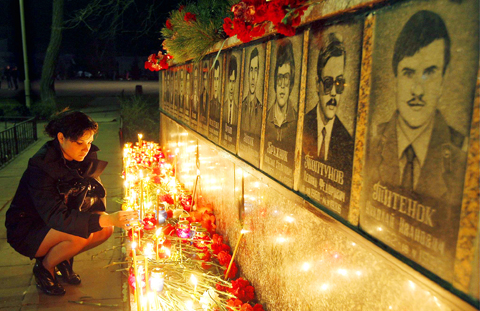
PHOTO: EPA
The “liquidators” — men who took part in cleaning the site after the catastrophe — in their turn wound a long fir-tree wreath around the monument, many unable to keep back tears.
In Slavutich, a small town 50km away from the accident’s site where many of the power station’s personnel used to live, the night vigil gathered many hundreds who brought flowers and candles to the Chernobyl victims’ monument.
The disaster occurred on April 26, 1986, at 1:23am, when one of the reactors exploded — contaminating the Soviet states of Ukraine, Russia and Belarus, with the fallout also spreading to other parts of Europe.
More than 25,000 liquidators — most of them Ukrainians, Russians and Belarussians — died getting the accident under control and constructing a concrete shield over the wreckage, Ukrainian official figures showed.
A UN toll published in September 2005 set the number of victims at just 4,000, a figure challenged by non-governmental organizations.
In Ukraine alone, 2.3 million people are designated officially as “having suffered from the catastrophe.”
Some 4,400 Ukrainians, children or adolescents at the time of the accident, have undergone operations for thyroid cancer, the most common consequence of radiation, the health ministry said.
Chernobyl nuclear power station was finally closed in 2000 after one reactor had continued producing electricity. But the dead power station remains a threat because the concrete cover laid over 200 tonnes of magma, consisting of radioactive fuel, is cracking.
A new steel sarcophagus is due to cover the seal hurriedly flung over the reactor in the immediate aftermath of the disaster. Internationally funded construction of the new steel cover is due to be launched this year or early next year and completed by 2012 by the Novarka consortium including France’s Bouygues and Vinci companies.
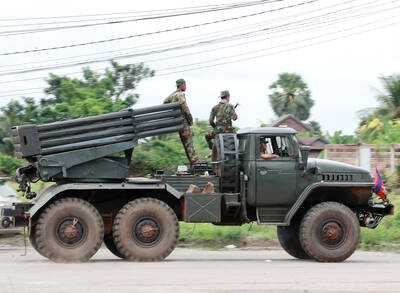
POLITICAL PATRIARCHS: Recent clashes between Thailand and Cambodia are driven by an escalating feud between rival political families, analysts say The dispute over Thailand and Cambodia’s contested border, which dates back more than a century to disagreements over colonial-era maps, has broken into conflict before. However, the most recent clashes, which erupted on Thursday, have been fueled by another factor: a bitter feud between two powerful political patriarchs. Cambodian Senate President and former prime minister Hun Sen, 72, and former Thai prime minister Thaksin Shinawatra, 76, were once such close friends that they reportedly called one another brothers. Hun Sen has, over the years, supported Thaksin’s family during their long-running power struggle with Thailand’s military. Thaksin and his sister Yingluck stayed
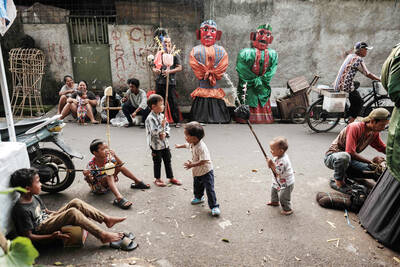
In the sweltering streets of Jakarta, buskers carry towering, hollow puppets and pass around a bucket for donations. Now, they fear becoming outlaws. City authorities said they would crack down on use of the sacred ondel-ondel puppets, which can stand as tall as a truck, and they are drafting legislation to remove what they view as a street nuisance. Performances featuring the puppets — originally used by Jakarta’s Betawi people to ward off evil spirits — would be allowed only at set events. The ban could leave many ondel-ondel buskers in Jakarta jobless. “I am confused and anxious. I fear getting raided or even
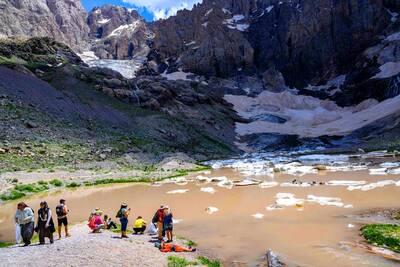
Kemal Ozdemir looked up at the bare peaks of Mount Cilo in Turkey’s Kurdish majority southeast. “There were glaciers 10 years ago,” he recalled under a cloudless sky. A mountain guide for 15 years, Ozdemir then turned toward the torrent carrying dozens of blocks of ice below a slope covered with grass and rocks — a sign of glacier loss being exacerbated by global warming. “You can see that there are quite a few pieces of glacier in the water right now ... the reason why the waterfalls flow lushly actually shows us how fast the ice is melting,” he said.
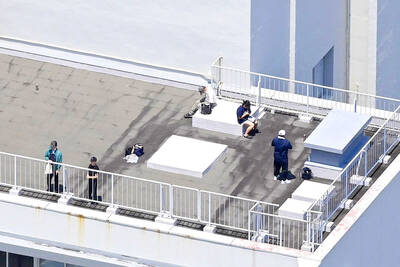
Residents across Japan’s Pacific coast yesterday rushed to higher ground as tsunami warnings following a massive earthquake off Russia’s far east resurfaced painful memories and lessons from the devastating 2011 earthquake and nuclear disaster. Television banners flashed “TSUNAMI! EVACUATE!” and similar warnings as most broadcasters cut regular programming to issue warnings and evacuation orders, as tsunami waves approached Japan’s shores. “Do not be glued to the screen. Evacuate now,” a news presenter at public broadcaster NHK shouted. The warnings resurfaced memories of the March 11, 2011, earthquake, when more than 15,000 people died after a magnitude 9 tremor triggered a massive tsunami that